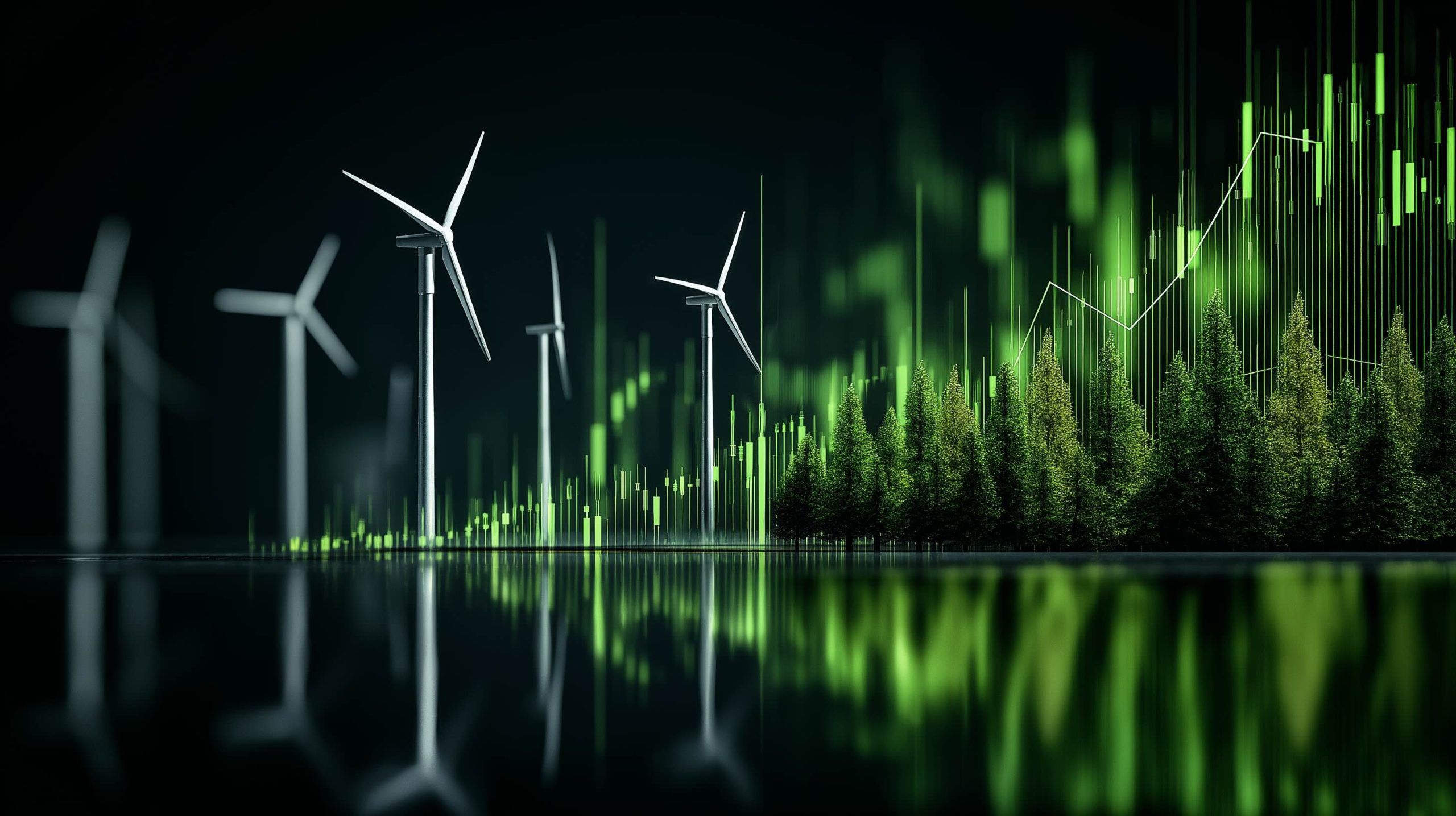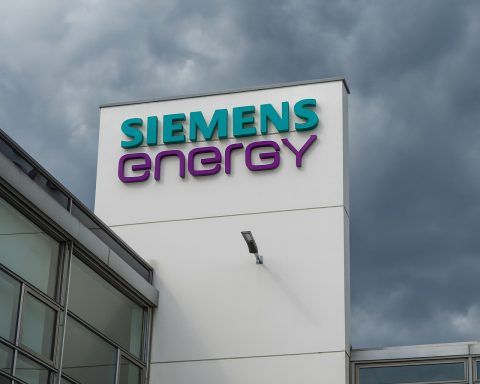Global clean energy is having a busy news day on 14 November 2025. From grid giants raising long‑term profit targets to solar manufacturers leaning hard into battery storage and domestic supply chains, today’s headlines highlight how fast the green energy landscape is shifting.
In the United States, developers have now safe‑harbored roughly 33 GW of wind and solar projects under the new One Big Beautiful Bill Act (OBBBA), locking in tax credits for most capacity slated to come online through 2028. [1] At the same time, power demand from AI data centers and electrification is forcing utilities and governments to accelerate investments in grids, storage and firming capacity—exactly the areas many of today’s stocks are targeting. [2]
Below are five green energy stocks that stand out today, 14 November 2025, based on fresh news, earnings and strategic updates. This is not investment advice, but a curated look at where the market’s attention is right now.
How today’s five stocks were selected
For this 14 November 2025 snapshot, the focus is on companies that:
- Released results, major project wins, or strategic updates today (or have key transactions closing today), and
- Are meaningfully exposed to renewable energy, grids, storage, or clean‑energy infrastructure, and
- Represent a mix of regions and business models (equipment, project developers, yieldcos, and manufacturers).
Always do your own due diligence and consider your risk tolerance before investing in any of these names.
1. Siemens Energy AG (XETR: ENR) – Grid & wind giant back on the front foot
Why it’s in the spotlight today
Siemens Energy, one of the world’s largest energy‑technology companies and parent of wind turbine maker Siemens Gamesa, reported record fiscal 2025 results and raised its mid‑term outlook this morning. [3]
Key highlights from the company’s Q4 and FY 2025 update:
- FY 2025 revenue: €39.1 billion, up about 15% year‑on‑year. [4]
- Profit before special items: €2.355 billion, with a margin of 6%, vs. €345 million in FY 2024. [5]
- Net income: €1.685 billion for the year. [6]
- Dividend comeback: Siemens Energy is proposing a €0.70 per‑share dividend, its first dividend in four years, after exiting a German state‑backed guarantee facility that had restricted payouts. [7]
- Raised 2028 targets: Management now targets low‑teens compound annual revenue growth and a 14–16% profit margin before special items by fiscal 2028. [8]
Investor reaction has been strong: one detailed recap notes that the stock jumped over 9% today after the presentation as the market digested the upgraded guidance and dividend restart. [9]
Why it matters for green‑energy investors
Although Siemens Energy still earns much of its profit from gas turbines and conventional equipment, its Grid Technologies and Siemens Gamesa wind units are central to the energy transition:
- The company’s technologies underpin an estimated one‑sixth of global electricity production, including renewables. [10]
- Grid expansion and reinforcement—transformers, HVDC lines, interconnectors—are crucial bottlenecks for adding solar and wind at scale. Siemens’ grid division is a major beneficiary of that capex wave. [11]
- Management explicitly links its growth outlook to surging electricity demand from data centers, electrification, and rising renewable penetration, which all require more grid capacity and smarter infrastructure. [12]
What to watch next
- Wind turnaround: Siemens Gamesa remains the weakest division, but losses are narrowing as quality and cost‑cutting initiatives take hold. Hitting break‑even in FY 2026 is key to maintaining investor confidence. [13]
- Execution risk: The record €138 billion order backlog is a strength, but also demands flawless project execution in a volatile cost environment. [14]
- Policy & rates: As a capital‑intensive industrial, Siemens is sensitive to interest rates and political pressure around large infrastructure projects.
For long‑term green‑infrastructure exposure, Siemens Energy is now trading with a much stronger balance sheet, restored dividend, and clearer growth roadmap than it had even a year ago.
2. Canadian Solar Inc. (NASDAQ: CSIQ) – Storage surges as modules slump
Today’s earnings & project news
Canadian Solar is one of the world’s largest solar and battery storage players. Today, two news streams are shaping the stock’s story:
- Q3 2025 results show a pivot toward storage.
- Q3 revenue came in around US$1.5 billion, at the top end of guidance and above market expectations. [15]
- Gross margin was 17.2%, down from 29.8% in Q2 but slightly above the 16.4% margin a year ago. [16]
- The company posted a loss of US$0.58 per share, or US$26 million net loss, as weaker module pricing and the absence of a one‑off high‑margin project weighed on profitability. [17]
- CSI Solar shipped 5.1 GW of PV modules, down sharply from 7.9 GW in Q2, but delivered a record 2.7 GWh of battery energy storage systems (BESS), beating its own guidance. [18]
- A major new storage contract in Ontario.
- Canadian Solar’s e‑STORAGE unit has won a turnkey EPC and long‑term service contract for the Skyview 2 Energy Storage Project in Ontario: 411 MW / 1,858 MWh of grid‑scale storage. [20]
- e‑STORAGE will supply around 390 SolBank 3.0 battery units, with shipments starting in February 2026and commercial operation targeted for Q2 2027. [21]
- The business will also handle system integration, substation and balance‑of‑plant work, plus a 21‑year service agreement, deepening its recurring‑revenue profile. [22]
- Across North America, Canadian Solar now has 8 GWh of deployed storage projects and a 24+ GWh storage development pipeline, positioning it as one of the key beneficiaries of grid‑modernization and reliability spending. [23]
Why it’s one of today’s most interesting green stocks
For years, Canadian Solar traded primarily as a commodity‑exposed module manufacturer. Today’s news accelerates a visible shift:
- Earnings commentary emphasizes profitable markets (especially North America) over pure shipping volume, and a focus on storage where pricing power is better. [24]
- New U.S. factories in Indiana (cells) and Kentucky (batteries), slated to start production in 2026, are designed to align with U.S. content rules and FEOC restrictions, which could unlock more incentive‑eligible projects in coming years. [25]
Risks & watchpoints
- Module price pressure remains intense, and the company is still posting net losses despite strong storage growth. [26]
- Canadian Solar has a sizeable debt load (~US$6.4 billion) as of Q3 2025, which investors should watch closely in a higher‑rate environment. [27]
- Policy uncertainty around tariffs and FEOC rules could reshape where and how Canadian Solar manufactures.
Still, for investors looking at battery‑storage and solar‑plus‑storage as a growth theme, Canadian Solar’s combination of scale, manufacturing footprint and project pipeline makes CSIQ one of today’s headline green energy names.
3. T1 Energy Inc. (NYSE: TE) – A high‑beta bet on U.S. solar manufacturing
What T1 announced this morning
T1 Energy is building an integrated U.S. supply chain for solar and batteries, with a large module plant in Dallas (“G1_Dallas”) and a planned advanced cell fab in Rockdale, Texas (“G2_Austin”). Today’s Q3 2025 earnings release adds detail to that story. [28]
From the Q3 report and presentation:
- T1 expects Q4 2025 module sales to exceed the total sales of the first three quarters combined, with G1_Dallas hitting a 4.5 GW annualized production run‑rate by year‑end. [29]
- The company reaffirmed 2025 EBITDA guidance of US$25–50 million, despite a weak Q3 impacted by a disputed offtake contract and related non‑cash impairment. [30]
- T1 is accelerating work on G2_Austin, targeting:
- 60% engineering completion this month,
- Construction start in Q4 2025, and
- First production in Q4 2026 for Phase 1 (2.1 GW of cell capacity), at an estimated US$400–425 million capex. [31]
- When G1_Dallas (5 GW) and the first 2.1 GW phase of G2_Austin are fully ramped, T1 estimates annual run‑rate EBITDA of US$375–450 million, highlighting the embedded operating leverage if everything goes right. [32]
- The company raised roughly US$122 million in recent equity and preferred deals, including a reworked agreement with Encompass Capital Advisors, and has accrued US$93 million of Section 45X production tax credits it expects to monetize. [33]
On the downside, T1 reported a Q3 net loss of US$140.8 million, driven partly by a US$53.2 million non‑cash impairment tied to an offtake dispute. [34]
The bigger picture: AI, data centers and U.S. policy
Today’s slide deck leans heavily into two structural themes:
- AI and data centers: T1 cites forecasts that AI and data centers could consume over 11% of U.S. electricity by 2030, arguing that domestic solar manufacturing will be critical to meet that demand with low‑carbon power. [35]
- Policy tailwinds: T1 is positioning itself as a winner from Section 45X manufacturing credits and potential tariffs on foreign polysilicon under Section 232, while also racing to stay compliant with evolving rules under OBBBA and FEOC restrictions. [36]
Why TE is “interesting” rather than “safe”
T1 Energy’s stock has been extremely volatile in 2025 as it pivots from a legacy European portfolio to a high‑capex U.S. manufacturing model. Recent trading data show double‑digit daily swings as investors reassess the risk‑reward. [37]
Key things to watch:
- Ability to lock in long‑term offtake contracts for G2_Austin at attractive pricing. [38]
- Execution on construction timelines and capex budgets.
- Liquidity and funding – particularly if capital markets become less receptive.
For investors who believe in onshoring the solar supply chain and are comfortable with high risk and volatility, T1 is one of the purest plays in the news today.
4. Adani Green Energy Ltd. (NSE: ADANIGREEN) – Pumped hydro and a mega investment in Assam
Today’s big announcement
Adani Green Energy, the renewables arm of India’s Adani Group, is in focus after the conglomerate unveiled plans to invest about ₹630 billion (~US$7.2 billion) in new power projects in the north‑eastern state of Assam. [39]
The package includes:
- A 3.2 GW coal‑fired plant via Adani Power, and
- Two pumped storage projects (PSPs) totaling 2,700 MW under Adani Green Energy, with AGEL expected to invest around ₹150 billion (~US$1.7 billion). [40]
On the renewables side specifically, Adani Green:
- Has received a Letter of Award (LOA) from the Assam Power Distribution Company Limited (APDCL) for 500 MW of pumped hydro storage capacity, awarded via a competitive tender. [41]
- Will earn an annual fixed cost of ₹1,02,92,887 per MW for 40 years from commercial operation, providing unusually long‑term revenue visibility. [42]
A separate Reuters report notes that Adani Green already has 16.7 GW of renewable capacity and is targeting 50 GW by 2030, making it one of the world’s largest private clean‑energy developers. [43]
On the market side, a trading update today shows Adani Green’s share price around ₹1,080, with gains of roughly 17% over the past three months as investors price in its growing pipeline. [44]
Why pumped hydro matters for green investors
Pumped storage is an unsung hero of the energy transition:
- It provides multi‑hour to multi‑day energy storage, enabling grids to absorb large volumes of solar and wind while maintaining reliability.
- India’s fast‑growing renewable base, plus unstable monsoon patterns, make flexible storage particularly valuable.
Adani Green’s Assam projects are strategically important because they:
- Anchor a regional hub for storage‑backed renewables in India’s under‑served north‑east. [45]
- Lock in decades‑long cash flows through 40‑year contracts, which could support further project financing and expansion. [46]
ESG and risk considerations
Adani Group remains controversial:
- The same Assam package that funds pumped storage also includes a large coal‑fired power project, which many environmental investors will consider incompatible with strict decarbonization mandates. [47]
- The wider group has faced governance and regulatory scrutiny in recent years, which still weighs on ESG‑focused portfolios. [48]
For investors willing to hold nuanced positions—supporting renewable capacity and storage build‑out while acknowledging the coal exposure—Adani Green is one of the most consequential clean‑energy developers making headlines today.
5. clearvise AG (XETR: ABO) – A small‑cap European yieldco planning a long‑term dividend
The 9‑month update investors are digesting today
clearvise AG is a Frankfurt‑listed renewable power producer with a diversified European portfolio of wind and solar plants. This morning, the company published its 9M 2025 figures and outlined a new dividend roadmap. [49]
Key points:
- Revenue: €27.4 million for the first nine months of 2025, essentially flat year‑on‑year (vs. €27.5 million in 9M 2024). [50]
- Adjusted EBITDA: up to €19.1 million from €18.5 million, despite weaker wind conditions and temporary grid shutdowns due to negative power prices. [51]
- Production: 335.1 GWh across the portfolio, impacted by below‑average wind in Q1. [52]
- Operating cash flow: jumped more than 40% to €17.9 million, strengthening the company’s ability to self‑fund growth and distributions. [53]
- Balance sheet: equity ratio of 37% as of 30 September 2025 (down from 42% at year‑end 2024), still reasonable for an asset‑heavy yieldco model. [54]
Most interesting for income‑oriented investors, clearvise is proposing a “shareholder‑friendly five‑year dividend strategy”, signaling a commitment to regular payouts as cash flows stabilize. [55]
On valuation metrics, recent data show:
- Share price around €1.4–1.5,
- Price‑to‑book near 0.66,
- Price‑to‑sales just under 3x, with institutional ownership still relatively low. [56]
Why clearvise makes today’s list
Unlike high‑growth developers, clearvise is more of a steady, asset‑backed income play:
- Its “YieldCo”‑style portfolio of operational wind and PV assets provides relatively predictable generation, subject to weather and power price volatility. [57]
- The planned dividend policy and improved operating cash flow could help narrow the discount to book value if the market gains confidence in the payout profile. [58]
On the risk side:
- The company is exposed to European power‑price regulation, curtailment risk and negative price episodes, which it explicitly calls out in today’s release. [59]
- As a small‑cap with relatively thin trading volumes, the stock may be more volatile and less liquid than larger peers.
Still, for investors scanning beyond mega‑caps, clearvise is one of today’s more interesting European pure‑play renewables stocks in the news.
Sector pulse: a quick note on the broader green‑energy trade
While this article focuses on five individual names, it’s worth noting that broad clean‑energy benchmarks are stirring as well. The First Trust NASDAQ Clean Edge Green Energy Index Fund (QCLN)—an ETF tracking a basket of U.S. clean‑energy stocks—has just moved back above its 50‑day moving average, a technical sign that sector momentum may be stabilizing after a rough period. [60]
Combined with LevelTen’s finding that U.S. developers have safe‑harbored most near‑term projects under OBBBA, today’s headlines suggest that while policy and cost challenges remain, visibility for 2025–2028 renewables build‑out is improving. [61]
Final thoughts & disclaimer
On 14 November 2025, these five names stand out for different reasons:
- Siemens Energy – grid and wind heavyweight with a restored dividend and upgraded long‑term targets.
- Canadian Solar – solar stalwart reinventing itself as a storage leader with a massive new Ontario contract.
- T1 Energy – high‑risk, high‑upside bet on U.S. solar manufacturing and AI‑driven power demand.
- Adani Green Energy – central to India’s pumped‑storage build‑out, with huge capacity ambitions and complex ESG trade‑offs.
- clearvise AG – a small European yieldco signalling long‑term dividends and robust cash generation.
None of this is a recommendation to buy or sell any security. It’s a news‑driven overview of where attention is focused today in green energy. Always evaluate your own financial situation, risk tolerance and investment horizon, and consider consulting a qualified advisor before making investment decisions.
References
1. www.pv-magazine.com, 2. www.siemens-energy.com, 3. www.siemens-energy.com, 4. www.siemens-energy.com, 5. www.siemens-energy.com, 6. www.siemens-energy.com, 7. www.siemens-energy.com, 8. www.siemens-energy.com, 9. in.investing.com, 10. www.siemens-energy.com, 11. www.siemens-energy.com, 12. www.siemens-energy.com, 13. www.siemens-energy.com, 14. www.siemens-energy.com, 15. www.pv-tech.org, 16. www.pv-tech.org, 17. www.pv-tech.org, 18. www.pv-tech.org, 19. www.pv-tech.org, 20. www.nasdaq.com, 21. www.nasdaq.com, 22. www.nasdaq.com, 23. www.nasdaq.com, 24. www.pv-tech.org, 25. www.pv-tech.org, 26. www.pv-tech.org, 27. www.pv-tech.org, 28. www.globenewswire.com, 29. www.globenewswire.com, 30. www.globenewswire.com, 31. www.globenewswire.com, 32. www.globenewswire.com, 33. www.globenewswire.com, 34. www.globenewswire.com, 35. au.investing.com, 36. www.globenewswire.com, 37. stockanalysis.com, 38. www.globenewswire.com, 39. www.reuters.com, 40. www.reuters.com, 41. www.angelone.in, 42. www.angelone.in, 43. www.reuters.com, 44. www.angelone.in, 45. www.reuters.com, 46. www.angelone.in, 47. www.reuters.com, 48. en.wikipedia.org, 49. markets.ft.com, 50. markets.ft.com, 51. markets.ft.com, 52. markets.ft.com, 53. www.finanzen.ch, 54. www.finanzen.ch, 55. markets.ft.com, 56. www.finanzen.ch, 57. markets.ft.com, 58. www.finanzen.ch, 59. markets.ft.com, 60. www.marketbeat.com, 61. www.pv-magazine.com









